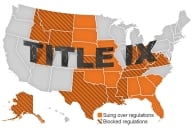You have /5 articles left.
Sign up for a free account or log in.
Any instructor who has ever given students a writing assignment that affords them latitude to pick the topic has heard this one: “ So, uh, what should I write about?”
Recounting such conversations, Scott Warnock, an assistant professor of English at Drexel University and director of the Freshman Writing Program, lights up. “What can’t you write about and talk about?”
That’s the spirit behind “English Alive,” a pilot program at Drexel that shakes up freshman writing instruction by combining interactive projects with a hybrid (in-person and Web-based) class format. Warnock and colleagues described the mission and structure of the English 101 courses Friday at the National Council of Teachers of English annual convention in New York.
Eleven Drexel instructors combined to create the framework for the course, which was taught in 30 sections and for about 550 students last year. The classes are dormant this fall, but those behind the project hope the university -- and perhaps others -- will pick up on the concept. (Many faculty are incorporating aspects of the program into their courses this fall and using a hybrid format.)
If a typical first-year writing assignment asks, “What themes do you want to cover?, a typical English Alive assignment asks that, and also, “In what format do you want to express them: a poster, a podcast, a Web presentation, animation, or, perhaps, a traditional essay?
Students conduct interviews and observe interactions around Philadelphia, and then write about them. The course still includes instruction in expository writing and rhetoric, and instructors still talk about clarity, coherence, audience and role -- the buzzwords of any English 101 course. But many assignments include visual components on top of the writing. In other words, instructors say, it's about projects, not just papers.
“The conventional way that assignments are presented to students isn't always relevant to them,” Warnock said. “We can change that by trying to create context.”
Added Valarie Meliotes Arms, a professor of English who helped develop the program: “Some projects sound like they could be a traditional paper. But because we give students options, they don’t come in to us looking like regular assignments. We want it to be alive for them, so we are asking them to use what they already know.”
For instance, a student who's proficient at Web design can create pages as part of a project. Artists can make posters or design cartoons. And the course is heavy on what the instructors call "primary research." For one assignment, students find a group of strangers, listen to their conversation, take notes and reflect on their experiences as outsiders. Then they write about a time when they felt like they were on the periphery, and also read a literary text about being an outsider.
Drexel, with its popular co-op program, attracts students who are working part- or full-time and have a vocational mindset. So instructors in the program encourage them to think about completing projects that relate to their current job or desired career. Assignments ask students to explain how Philadelphia would be a promising location for a given profession, and, as a researcher for the fictional Science and Technology Administration, write a “white paper” that persuades the audience that a given work place or profession would be completely different -- and perhaps not exist at all -- without this technology.
“The payoff is when students make a connection between writing and the rest of their lives,” said Dan Driscoll, a visiting professor of English who’s involved in the project.
The program's other key component is its hybrid class structure. Students spend 80 minutes per week in class, and the equivalent amount of time posting messages on the class's Blackboard site. Software allows instructors to track not only how many entries students complete, but how many discussion threads they are reading and how much time they are spending on the site.
The instructors who put together the English Alive curriculum agreed that it had to include multimedia components and ask students to regularly post on message boards.
“This is where our students are -- there is no other way to put it,” Warnock said.
On the outsiders assignment, students turned in posts about their experiences on the course page along with a visual -- a photograph or image that illustrates the concept of outsider. Classmates comment on each others' work and sometimes recommend sources for projects. Instructors also have the option of asking students to turn in assignments online without others being able to view them.
Faculty involved in the program said some of their colleagues were concerned about giving up autonomy in the "wild west of teaching," as Warnock calls the online component. Class conversations go on without them in discussion threads, and instructors have to fight the urge to moderate.
“Faculty got over it when they learned that students were more creative when we weren’t around," Arms said.
Other instructors noticed that shyer students were putting more effort into posting than speaking up in class, and an audience member during the convention session said she worried about the class's format encouraging isolation.
Warnock said that hadn't been his experience with the course; Arms responded that students were anything but timid in challenging each other in the online threads.
And then there's the issue of writing style. English professors might cringe at the idea of grading posts filled with spelling errors and emoticons. Warnock said he asks his students to be semi-formal in posts, and treat their entries as mini-essays. But that doesn't preclude them from using the symbols and shorthand that is common in Web dialogue. Warnock said students know how to tailor their writing for their peers online, and then switch to a style that fits a more traditional assignment.
"They know how to turn it on and off," he said.








